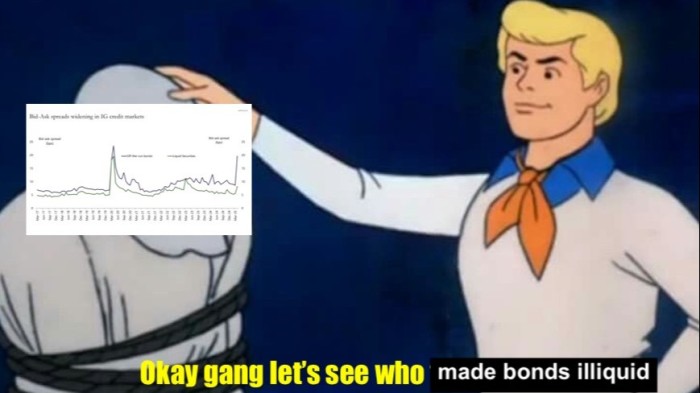Unlock the Editor’s Digest for free
Roula Khalaf, Editor of the FT, selects her favourite stories in this weekly newsletter.
A few weeks ago, Apollo’s chief economist Torsten Sløk sent around a chart showing how liquidity for “off-the-run” corporate bonds was the worst since March 2020. Pimco has now offered up an oblique riposte.
OK, Pimco‘s report insisting that there was “no significant stress in public credit market liquidity” was actually published last week, but at the time we were distracted. On the principle that it’s never too late to write about indirect passive-aggressive credit manager spats, let’s take a look.
The central point made by Mohit Mittal — Pimco’s chief investment officer for core strategies — is that this is a great time to buy bonds. Yes, we’re shocked too.
But the report does include a few good charts showing the bid-ask spread on US investment grade corporate debt rising but remaining below its longer-term average . . .
. . . and trading volumes going through the roof.
Last month’s Sløkchart goes entirely unmentioned, but it’s hard not to read this is as an indirect retort to Sløk saying that “off-the-run paper has become virtually untradeable”. As Mittal writes:
Recent Treasury sell-offs have sparked premature and unwarranted concerns about public fixed income valuations and liquidity, particularly in public credit. Despite the volatility induced by recent tariff announcements, bond liquidity remains robust, with no material signs of stress in public IG credit. As is typical during periods of heightened volatility, public credit (IG) bid-ask spreads have widened — a trend that has historically, at times, indicated a more challenging environment for liquidity. However, current spreads remain well within their longterm average range and are below the peaks seen during 2022’s volatility.
Alphaville received a fair few emails from credit investors calling Apollo’s research baloney (some were ruder than that), but there is an important distinction here that Pimco doesn’t really address.
Apollo’s chart specifically looked at bid-ask spreads on sub-$900mn bonds issued at least two years ago, ie slightly stale, less-traded “off-the-run” securities. These were the ones that Sløk called “virtually untradeable”, not the liquid half of the US corporate bond market.
Now, Alphaville has some issues with Apollo’s use of dealer quotes here, given how a lot of trading nowadays happens through various platforms. And we simply don’t buy that off-the-run liquidity has been as bad this month as it was in March 2020, when even US Treasuries became illiquid.
But Pimco et al highlighting the resilience of investment grade corporate debt — both in terms of liquidity and prices — doesn’t necessarily refute the narrower point that off-the-run liquidity seems to have deteriorated particularly sharply. Perhaps not March 2020-bad, but it’s certainly not been great.
The question is why. We’ve had a few thoughts since our last speculative post, and sanity-tested them with a few smart credit people. This is mostly a theory — and might be a case of hammers seeing nails everywhere — but it’s probably related to the growth of bond ETFs.
As a senior industry figure told us for a chunky Alphaville post on the subject last year:
The underlying bond market has become almost like a two-way speedway. Bonds that are on those investible lists are increasingly liquid, because you can create them into an ETF or break the ETF apart and take them back. But bonds that aren’t on these investible lists have become more illiquid.
Basically, the creation-redemption technology that underpins ETFs and the resulting boom in portfolio and electronic trading have made the liquid bits of the corporate bond market far more liquid, even at times of stress. However, bonds that are less liquid — and thus aren’t in as many bond indices, bond ETFs or bond portfolios — become less liquid both in relative and absolute terms.
In other words, all that extra activity in the healthier corner of the credit market actually detracts a little from the vibrancy of the rest of the market. And this becomes particularly and increasingly stark at stressful times, when investors always gravitate towards more liquid securities anyway.
Imagine a supermarket where shoppers will naturally favour fresher foods, but many will be happy to snag some bargain-priced steaks or bananas with a few blotches. However, in a health scare over short-dated foods almost everyone will want the best stuff. ETFs are like a new fancy fridge that keeps food looking even more enticing for longer, but drags shoppers away from the bargain bin.
OK, this is probably a very bad metaphor, but hopefully you get the drift. How sure are we that our ETF cannibalisation theory helps explain Apollo’s findings and the views of Pimco et al? Only moderately. Please get in touch if you have a better theory.
https://www.ft.com/content/010fda33-45c1-40af-b7a3-f4fce8f704a5


